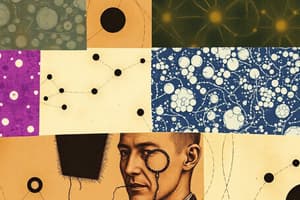Podcast
Questions and Answers
What is primarily discussed in Lesson 3?
What is primarily discussed in Lesson 3?
- Genetic Engineering
- Cellular Transport (correct)
- Human Anatomy
- Animal and Plant Tissues
Which of the following is likely a topic under the discussion of 'Animal and Plant Tissues'?
Which of the following is likely a topic under the discussion of 'Animal and Plant Tissues'?
- Plant structural functions (correct)
- Diffusion across cell membranes
- Types of cellular respiration
- Mitosis process
What does the phrase 'Pellentesque habitant morbi tristique senectus' suggest?
What does the phrase 'Pellentesque habitant morbi tristique senectus' suggest?
- Understanding cell division
- Focus on aging and its effects (correct)
- Study of microbial impacts
- Importance of nutrition in tissues
What might 'Proin pharetra nonummy pede' imply about cellular structures?
What might 'Proin pharetra nonummy pede' imply about cellular structures?
Which function is NOT typically associated with cellular transport?
Which function is NOT typically associated with cellular transport?
What could be inferred from the mention of 'Fusce posuere'?
What could be inferred from the mention of 'Fusce posuere'?
How might the structure of 'Mauris et orci' relate to cellular dynamics?
How might the structure of 'Mauris et orci' relate to cellular dynamics?
In the context of cellular functions, what does 'magna sed pulvinar ultricies' likely refer to?
In the context of cellular functions, what does 'magna sed pulvinar ultricies' likely refer to?
What was a significant contribution of Antonie van Leeuwenhoek to microscopy?
What was a significant contribution of Antonie van Leeuwenhoek to microscopy?
Which scientist is credited with the invention of the electron microscope?
Which scientist is credited with the invention of the electron microscope?
Which of the following statements correctly expresses a tenet of the cell theory?
Which of the following statements correctly expresses a tenet of the cell theory?
What is a function of the ocular lens in a microscope?
What is a function of the ocular lens in a microscope?
Which key development significantly improved the resolving power of microscopes?
Which key development significantly improved the resolving power of microscopes?
Which of these scientists was recognized for their work in developing super-resolution microscopy?
Which of these scientists was recognized for their work in developing super-resolution microscopy?
Which of the following statements is NOT a historical milestone in microscopy?
Which of the following statements is NOT a historical milestone in microscopy?
What does the term 'resolving power' refer to in microscopy?
What does the term 'resolving power' refer to in microscopy?
In which century was the electron microscope developed?
In which century was the electron microscope developed?
Which component of a microscope helps to illuminate the specimen?
Which component of a microscope helps to illuminate the specimen?
Flashcards are hidden until you start studying
Study Notes
Microscopy and The Cell
- Historical development of the microscope crucial for understanding cell biology.
- Key figures include Hans and Zacharias Janssen, Antonie van Leeuwenhoek, Robert Hooke, Ernst Ruska, and various 20th-century innovators like Eric Betzig and William Moerner.
Key Contributors to Microscopy
- Hans and Zacharias Janssen: First to create the compound microscope.
- Antonie van Leeuwenhoek: Observed single-celled organisms; known as the "father of microbiology."
- Robert Hooke: Coined the term "cell" after observing cork.
- Ernst Abbe: Contributed to theoretical foundations of optics.
- Ernst Ruska: Developed the first electron microscope, enhancing resolution far beyond light microscopes.
Cell Theory
- Central concepts in biology: All living things are made of cells; the cell is the basic unit of life; all cells arise from pre-existing cells.
- Important in understanding the structure and function of living organisms.
Microscope Components
- Eyepiece: Contains the lens through which the viewer looks.
- Objective lenses: Varying magnification levels for detailed observation.
- Stage: Platform where slides are placed.
- Light source: Illuminates the specimen, crucial for visibility.
Cellular Transport
- Mechanisms by which substances move in and out of cells.
- Includes passive (diffusion, osmosis) and active transport (requiring energy).
Tissues in Plants and Animals
- Animal tissues include epithelial, connective, muscle, and nervous tissue.
- Plant tissues are classified into meristematic and permanent tissues, each serving specific functions in growth and support.
Learning Objectives
- Gain insight into the evolution of microscopy.
- Understand microscope mechanics for enhanced observational skills.
- Apply the principles of cell theory to biological studies.
Studying That Suits You
Use AI to generate personalized quizzes and flashcards to suit your learning preferences.





